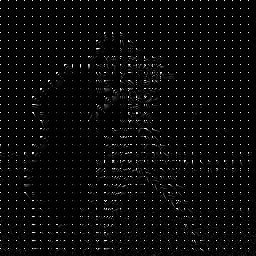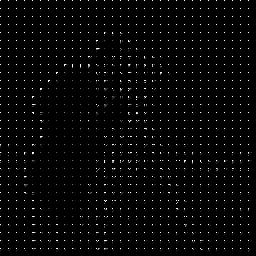Preface
参考主要来自 https://cp-algorithms.com/algebra/fft.html, https://en.wikipedia.org/wiki/Discrete_Fourier_transform, https://oi.wiki/math/poly/fft/
为照顾某OJ 本文例程(杂项除外)C++标准仅需11;板子传送门,题目传送门
定义
- 多项式$A$的$DFT$即为$A$在各单位根$w_{n, k} = w_n^k = e^{\frac{2 k \pi i}{n}}$之值
$$ \begin{align} \text{DFT}(a_0, a_1, \dots, a_{n-1}) &= (y_0, y_1, \dots, y_{n-1}) \newline &= (A(w_{n, 0}), A(w_{n, 1}), \dots, A(w_{n, n-1})) \newline &= (A(w_n^0), A(w_n^1), \dots, A(w_n^{n-1})) \end{align} $$
- $IDFT$ ($InverseDFT$) 即从这些值$(y_0, y_1, \dots, y_{n-1})$恢复多项式$A$的系数
$$ \text{IDFT}(y_0, y_1, \dots, y_{n-1}) = (a_0, a_1, \dots, a_{n-1}) $$
单位根有以下性质
积性 $$ w_n^n = 1 \newline w_n^{\frac{n}{2}} = -1 \newline w_n^k \ne 1, 0 \lt k \lt n $$
所有单位根和为$0$ $$ \sum_{k=0}^{n-1} w_n^k = 0 $$ 这点利用欧拉公式$e^{ix} = cos x + i\ sin x$看$n$边形对称性很显然
应用
考虑两个多项式$A, B$相乘 $$ (A \cdot B)(x) = A(x) \cdot B(x) $$
- 显然运用$DFT$可得
$$ DFT(A \cdot B) = DFT(A) \cdot DFT(B) $$
- $A \cdot B$的系数易求
$$ A \cdot B = IDFT(DFT(A \cdot B)) = IDFT(DFT(A) \cdot DFT(B)) $$
逆操作(IDFT)
回忆$DFT$的定义 $$ \text{DFT}(a_0, a_1, \dots, a_{n-1}) = (A(w_n^0), A(w_n^1), \dots, A(w_n^{n-1})) $$
- 写成矩阵形式即为
$$ F = \begin{pmatrix} w_n^0 & w_n^0 & w_n^0 & w_n^0 & \cdots & w_n^0 \newline w_n^0 & w_n^1 & w_n^2 & w_n^3 & \cdots & w_n^{n-1} \newline w_n^0 & w_n^2 & w_n^4 & w_n^6 & \cdots & w_n^{2(n-1)} \newline w_n^0 & w_n^3 & w_n^6 & w_n^9 & \cdots & w_n^{3(n-1)} \newline \vdots & \vdots & \vdots & \vdots & \ddots & \vdots \newline w_n^0 & w_n^{n-1} & w_n^{2(n-1)} & w_n^{3(n-1)} & \cdots & w_n^{(n-1)(n-1)} \end{pmatrix} \newline $$
- 那么$DFT$操作即为
$$ F\begin{pmatrix} a_0 \newline a_1 \newline a_2 \newline a_3 \newline \vdots \newline a_{n-1} \end{pmatrix} = \begin{pmatrix} y_0 \newline y_1 \newline y_2 \newline y_3 \newline \vdots \newline y_{n-1} \end{pmatrix} $$
- 化简有
$$ y_k = \sum_{j=0}^{n-1} a_j w_n^{k j}, $$
其中范德蒙德阵$M$行列各项正交,可做出结论:
$$ F^{-1} = \frac{1}{n} F^\star, F_{i,j}^\star = \overline{F_{j,i}} $$
既有 $$ F^{-1} = \frac{1}{n} \begin{pmatrix} w_n^0 & w_n^0 & w_n^0 & w_n^0 & \cdots & w_n^0 \newline w_n^0 & w_n^{-1} & w_n^{-2} & w_n^{-3} & \cdots & w_n^{-(n-1)} \newline w_n^0 & w_n^{-2} & w_n^{-4} & w_n^{-6} & \cdots & w_n^{-2(n-1)} \newline w_n^0 & w_n^{-3} & w_n^{-6} & w_n^{-9} & \cdots & w_n^{-3(n-1)} \newline \vdots & \vdots & \vdots & \vdots & \ddots & \vdots \newline w_n^0 & w_n^{-(n-1)} & w_n^{-2(n-1)} & w_n^{-3(n-1)} & \cdots & w_n^{-(n-1)(n-1)} \end{pmatrix} $$
- 那么$IDFT$操作即为
$$ \begin{pmatrix} a_0 \newline a_1 \newline a_2 \newline a_3 \newline \vdots \newline a_{n-1} \end{pmatrix} = F^{-1} \begin{pmatrix} y_0 \newline y_1 \newline y_2 \newline y_3 \newline \vdots \newline y_{n-1} \end{pmatrix} $$
- 化简有
$$ a_k = \frac{1}{n} \sum_{j=0}^{n-1} y_j w_n^{-k j} $$
结论
- 注意到$w_i$使用共轭即为$n \cdot \text{IDFT}$
- 实现中稍作调整即可同时实现$DFT,IDFT$操作;接下来会用到
实现(FFT)
朴素包络时间复杂度为$O(n^2)$,这里不做阐述
$FFT$的过程如下
- 令 $A(x) = a_0 x^0 + a_1 x^1 + \dots + a_{n-1} x^{n-1}$, 按奇偶拆成两个子多项式
$$ \begin{align} A_0(x) &= a_0 x^0 + a_2 x^1 + \dots + a_{n-2} x^{\frac{n}{2}-1} \newline A_1(x) &= a_1 x^0 + a_3 x^1 + \dots + a_{n-1} x^{\frac{n}{2}-1} \end{align} $$
- 显然有
$$ A(x) = A_0(x^2) + x A_1(x^2). $$
- 设 $$ \left(y_k^0 \right)_{k=0}^{n/2-1} = \text{DFT}(A_0) $$
$$ \left(y_k^1 \right)_{k=0}^{n/2-1} = \text{DFT}(A_1) $$
$$ y_k = y_k^0 + w_n^k y_k^1, \quad k = 0 \dots \frac{n}{2} - 1. $$
- 对后半 $\frac{n}{2}$ 有
$$ \begin{align} y_{k+n/2} &= A\left(w_n^{k+n/2}\right) \newline &= A_0\left(w_n^{2k+n}\right) + w_n^{k + n/2} A_1\left(w_n^{2k+n}\right) \newline &= A_0\left(w_n^{2k} w_n^n\right) + w_n^k w_n^{n/2} A_1\left(w_n^{2k} w_n^n\right) \newline &= A_0\left(w_n^{2k}\right) - w_n^k A_1\left(w_n^{2k}\right) \newline &= y_k^0 - w_n^k y_k^1 \end{align} $$
- 即$y_{k+n/2} = y_k^0 - w_n^k y_k^1$,形式上非常接近$y_k$。综上:
$$ \begin{align} y_k &= y_k^0 + w_n^k y_k^1, &\quad k = 0 \dots \frac{n}{2} - 1, \newline y_{k+n/2} &= y_k^0 - w_n^k y_k^1, &\quad k = 0 \dots \frac{n}{2} - 1. \end{align} $$
该式即为所谓 “蝶形优化”
结论
- 很显然合并代价是$O(n)$;由$T_{\text{DFT}}(n) = 2 T_{\text{DFT}}\left(\frac{n}{2}\right) + O(n)$则知$FFT$可在$O(nlogn)$时间内解决问题
- 归并实现也将很简单
Code (归并)
又称 库利-图基演算法(Cooley-Tukey algorithm);分治解决
- 若使用
std::complex实现$w_n$可以直接用std::exp自带特化求得$w_n = e^{\frac{2\pi i}{n}}$ - 或者利用欧拉公式$e^{ix} = cos x + i\ sin x$可构造
Complex w_n{ .real = cos(2 * PI / n), .imag = sin(2 * PI / n) } - 结合之前所述的$DFT$, $IDFT$关系,使用$w_n = -e^{\frac{2\pi i}{n}}$并除$n$即求$IDFT$
- 时间复杂度$O(n\log n)$,由于对半分后归并,空间复杂度$O(n)$
void FFT(cvec& A, bool invert) {
ll n = A.size();
if (n == 1) return;
cvec A0(n / 2), A1(n / 2);
for (ll i = 0; i < n / 2; i++)
A0[i] = A[i * 2], A1[i] = A[i * 2 + 1];
FFT(A0, invert), FFT(A1, invert);
Complex w_n = exp(Complex{ 0, 2 * PI / n });
if (invert)
w_n = conj(w_n);
Complex w_k = Complex{ 1, 0 };
for (ll k = 0; k < n / 2; k++) {
A[k] = A0[k] + w_k * A1[k];
A[k + n / 2] = A0[k] - w_k * A1[k];
// 注意:除 log2(n) 次 2 即除 2^log2(n) = n
if (invert)
A[k] /= 2, A[k + n / 2] /= 2;
w_k *= w_n;
}
}
void FFT(cvec& a) { FFT(a, false); }
void IFFT(cvec& y) { FFT(y, true); }
Code (倍增)
归并法带来的额外空间其实可以优化掉——接下来介绍倍增法递推解决。
观察归并中最后回溯的顺序(以 $n=8$为例)
- 初始序列为 ${x_0, x_1, x_2, x_3, x_4, x_5, x_6, x_7}$
- 一次二分之后 ${x_0, x_2, x_4, x_6},{x_1, x_3, x_5, x_7 }$
- 两次二分之后 ${x_0,x_4} {x_2, x_6},{x_1, x_5},{x_3, x_7 }$
- 三次二分之后 ${x_0}{x_4}{x_2}{x_6}{x_1}{x_5}{x_3}{x_7 }$
注意力足够的话可以发现规律如下
In [17]: [int(bin(i)[2:].rjust(3,'0')[::-1],2) for i in range(8)]
Out[17]: [0, 4, 2, 6, 1, 5, 3, 7]
In [18]: [bin(i)[2:].rjust(3,'0')[::-1] for i in range(8)]
Out[18]: ['000', '100', '010', '110', '001', '101', '011', '111']
In [19]: [bin(i)[2:].rjust(3,'0') for i in range(8)]
Out[19]: ['000', '001', '010', '011', '100', '101', '110', '111']
- 即二进制倒序(对称),记该倒序为 $R(x)$
auto R = [n](ll x) {
ll msb = ceil(log2(n)), res = 0;
for (ll i = 0;i < msb;i++)
if (x & (1 << i))
res |= 1 << (msb - 1 - i);
return res;
};
- 从下至上,以长度为$2,4,6,\cdots,n$递推,保持该顺序即可完成归并法所完成的任务
- 又因为对称,调整顺序也可在$O(n)$内完成;时间复杂度$O(n\log n)$,空间复杂度$O(1)$
void FFT(cvec& A, bool invert) {
ll n = A.size();
auto R = [n](ll x) {
ll msb = ceil(log2(n)), res = 0;
for (ll i = 0;i < msb;i++)
if (x & (1 << i))
res |= 1 << (msb - 1 - i);
return res;
};
// Resort
for (ll i = 0;i < n;i++)
if (i < R(i))
swap(A[i], A[R(i)]);
// 从下至上n_i = 2, 4, 6,...,n直接递推
for (ll n_i = 2;n_i <= n;n_i <<= 1) {
Complex w_n = exp(Complex{ 0, 2 * PI / n_i });
if (invert) w_n = conj(w_n);
for (ll i = 0;i < n;i += n_i) {
Complex w_k = Complex{ 1, 0 };
for (ll j = 0;j < n_i / 2;j++) {
Complex u = A[i + j], v = A[i + j + n_i / 2] * w_k;
A[i + j] = u + v;
A[i + j + n_i / 2] = u - v;
if (invert)
A[i+j] /= 2, A[i+j+n_i/2] /= 2;
w_k *= w_n;
}
}
}
}
void FFT(cvec& a) { FFT(a, false); }
void IFFT(cvec& y) { FFT(y, true); }
数论变换 (NTT)
虚数域内计算难免精度问题;数字越大误差越大且因为$exp$(或$sin, cos$)的使用极难修正。以下介绍数论变换(或快速数论变换)以允许在模数域下完成绝对正确的$O(nlogn)$包络。
在质数$p$, $F={\mathbb {Z}/p}$域下进行的DFT;注意到单位根的性质在模数下保留
同时显然的,有$$(w_n^m)^2 = w_n^n = 1 \pmod{p}, m = \frac{n}{2}$$;利用该性质我们可以利用快速幂求出$w_n^k$
当然,我们需要找到这样$g_n^n \equiv 1 \mod p$的$g$,使得$g_n$等效于$w_n$
原根
以下内容摘自:https://cp-algorithms.com/algebra/primitive-root.html#algorithm-for-finding-a-primitive-root,
定义:对任意$a$且存在$a$, $n$互质,且 $g^k \equiv a \mod n$,则称 $g$ 为模 $n$ 的原根。 结论:$n$的原根$g$,$g^k \equiv 1 \pmod n$, $k=\phi(n)$为$k$的最小解 下面介绍一种求原根的算法:
欧拉定义:若 $\gcd(a, n) = 1$,则 $a^{\phi(n)} \equiv 1 \pmod{n}$
对指数$p$, 朴素解法即为$O(n^2)$时间检查$g^d, d \in [0,\phi(n)] \not\equiv 1 \pmod n$
存在这样的$O(\log \phi (n) \cdot \log n)$解法:
- 找到$\phi(n)$因数$p_i \in P$,检查$g \in [1, n]$
- 对所有$p_i \in P$, $g ^ { \frac {\phi (n)} {p_i}} \not\equiv 1\pmod n $,此根即为一原根
证明请参见原文
#include "bits/stdc++.h"
using namespace std;
typedef long long ll; typedef vector<ll> vec;
ll binpow_mod(ll a, ll b, ll m) {
a %= m;
ll res = 1;
while (b > 0) {
if (b & 1) res = (__int128)res * a % m;
a = (__int128)a * a % m;
b >>= 1;
}
return res;
}
ll min_primitive_root(ll p) {
vec fac; ll phi = p - 1, n = phi;
for (ll i = 2; i * i <= n; i++)
if (n % i == 0) {
fac.push_back(i);
while (n % i == 0) n /= i;
}
if (n != 1) fac.push_back(n);
for (ll r = 2; r <= p; r++) {
bool ok = true;
for (ll i = 0; ok && i < fac.size(); i++)
ok &= binpow_mod(r, phi / fac[i], p) != 1;
if (ok) return r;
}
return -1;
}
// min_primitive_root(754974721) = 11
// min_primitive_root(998244353) = 3
// min_primitive_root(7340033) = 3
实现(倍增)
综上,有质数$p$及其原根$g$对即可做到模数域下的单位根性质;常用的有 ($p=7 \times 17 \times 2^{23}+1=998244353, g=3$,$p=7 \times 2^{20} + 1 =7340033$)
这些数的欧拉函数满足$\phi(p) = p - 1 = c \times 2^k$形式,回忆欧拉函数$g^{p-1} \equiv 1 \pmod n$,很显然这很适合接下来我们要做的事情:遍历到长度$n_i$时,$w_{n_i} = e^{\frac{2\pi}{n_i}}$即等效于$g^{\frac{p-1}{n_i}}$。由于$n_i$ 倍增,$\frac{p-1}{n_i}$即为简单移位,同时整数除法也将无误差。
Code (倍增)
void NTT(vec& A, ll p, ll g, bool invert) {
ll n = A.size();
auto R = [n](ll x) {
ll msb = ceil(log2(n)), res = 0;
for (ll i = 0;i < msb;i++)
if (x & (1 << i))
res |= 1 << (msb - 1 - i);
return res;
};
// Resort
for (ll i = 0;i < n;i++)
if (i < R(i)) swap(A[i], A[R(i)]);
// 从下至上n_i = 2, 4, 6,...,n直接递推
ll inv_2 = binpow_mod(2, p - 2, p);
for (ll n_i = 2;n_i <= n;n_i <<= 1) {
ll w_n = binpow_mod(g, (p - 1) / n_i, p);
if (invert)
w_n = binpow_mod(w_n, p - 2, p);
for (ll i = 0;i < n;i += n_i) {
ll w_k = 1;
for (ll j = 0;j < n_i / 2;j++) {
ll u = A[i + j], v = A[i + j + n_i / 2] * w_k;
A[i + j] = (u + v + p) % p;
A[i + j + n_i / 2] = (u - v + p) % p;
if (invert) {
A[i + j] = A[i + j] * inv_2 % p;
A[i + j + n_i / 2] = A[i + j + n_i / 2] * inv_2 % p;
}
w_k = w_k * w_n % p;
}
}
}
}
void FFT(vec& a) { NTT(a,998244353, 3, false); }
void IFFT(vec& y) { NTT(y, 998244353,3, true); }
余弦变换(DCT)
见下文实现;采用了以下$\text{DCT-II, DCT-III}$形式:
- DCT-2 及其正则化系数
$$ y_k = 2f \sum_{n=0}^{N-1} x_n \cos\left(\frac{\pi k(2n+1)}{2N} \right) \newline \begin{split}f = \begin{cases} \sqrt{\frac{1}{4N}} & \text{if }k=0, \ \sqrt{\frac{1}{2N}} & \text{otherwise} \end{cases}\end{split} $$
- DCT-3 $$ y_k = \frac{x_0}{\sqrt{N}} + \sqrt{\frac{2}{N}} \sum_{n=1}^{N-1} x_n \cos\left(\frac{\pi(2k+1)n}{2N}\right) $$
Reference (lib/poly.hpp)
本文所提及的$\text{DFT/FFT/(F)NTT}$魔术总结如下,开箱即用。
#include <span>
#include <cmath>
#include <vector>
#include <complex>
#include <numbers>
constexpr double PI = std::numbers::pi;
inline long long binpow_mod(long long a, long long b, long long m, long long res = 1) {
for (a %= m; b; b >>= 1) res = (b & 1) ? (res * a % m) : res, a = a * a % m;
return res;
};
inline bool is_pow2(const size_t x) { return (x & (x - 1)) == 0; }
enum class transform_result {
SUCCESS = 0,
INVALID_SIZE = 1,
INVALID_INPUT = 2,
INVALID_COEFFICIENT = 3,
};
template <typename T = size_t> struct bit_reversal {
std::vector<T> bit;
explicit bit_reversal(const size_t n) : bit(n) {
for (size_t i = 0; i < n; i++) {
bit[i] = bit[i >> 1] >> 1;
if (i & 1) bit[i] |= (n >> 1);
}
}
size_t operator[](size_t i) const { return bit[i]; }
};
template <typename Complex = std::complex<double>, bool Invert = false> struct FFT {
using value_t = Complex;
using span_t = std::span<value_t>;
class twiddle_factor {
std::vector<Complex> omega;
public:
explicit twiddle_factor(const size_t n) : omega(n) {
// \sum_{i=1}^{\log_2 n} 2^{i - 1} = 2^{\log_2 n} - 1 = n - 1
for (size_t n_i = 2, i = 1; n_i <= n; n_i <<= 1) {
Complex w_n = std::exp(Complex{ 0, -2 * PI / n_i });
if constexpr (Invert) w_n = std::conj(w_n);
Complex w_k = Complex{ 1, 0 };
for (size_t k_i = 0; k_i < n_i / 2; k_i++) {
omega[i++] = w_k;
w_k *= w_n;
}
}
}
Complex get(const size_t n_i, const size_t k_i) const { return omega[n_i / 2 + k_i]; }
const size_t size() const { return omega.size(); }
};
private:
const twiddle_factor omega;
const bit_reversal<> rev;
public:
const size_t size;
FFT(const size_t n) : omega(n), rev(n), size(n) {};
transform_result operator()(span_t a) const {
const size_t n = a.size();
if (!is_pow2(n) || size != n) return transform_result::INVALID_SIZE;
for (size_t i = 0, r; i < n; i++)
if (i < (r = rev[i])) std::swap(a[i], a[r]);
for (size_t n_i = 2; n_i <= n; n_i <<= 1) {
for (size_t i = 0; i < n; i += n_i) {
for (size_t j = 0; j < n_i / 2; j++) {
Complex u = a[i + j], v = a[i + j + n_i / 2] * omega.get(n_i, j);
a[i + j] = u + v;
a[i + j + n_i / 2] = u - v;
if constexpr (Invert) a[i + j] /= 2, a[i + j + n_i / 2] /= 2;
}
}
}
return transform_result::SUCCESS;
}
};
template <typename Complex = std::complex<double>> using IFFT = FFT<Complex, true>;
template <typename Integer = long long, bool Invert = false> struct NTT {
using value_t = Integer;
using span_t = std::span<value_t>;
class twiddle_factor {
std::vector<Integer> omega;
public:
explicit twiddle_factor(const size_t n, const Integer p, const Integer g) : omega(n) {
// \sum_{i=1}^{\log_2 n} 2^{i - 1} = 2^{\log_2 n} - 1 = n - 1
for (size_t n_i = 2, i = 1; n_i <= n; n_i <<= 1) {
Integer w_n = binpow_mod(g, (p - 1) / n_i, p);
if constexpr (Invert) w_n = binpow_mod(w_n, p - 2, p);
Integer w_k = 1;
for (size_t k_i = 0; k_i < n_i / 2; k_i++) {
omega[i++] = w_k;
w_k = w_n * w_k % p;
}
}
}
Integer get(const size_t n_i, const size_t k_i) const { return omega[n_i / 2 + k_i]; }
const size_t size() const { return omega.size(); }
};
private:
const twiddle_factor omega;
const bit_reversal<> rev;
public:
const Integer p, g, inv2;
const size_t size;
NTT(const size_t n, const Integer p, const Integer g)
: omega(n, p, g), rev(n), size(n), p(p), g(g), inv2(binpow_mod(2, p - 2, p)) {};
transform_result operator()(span_t a) const {
const size_t n = a.size();
if (!is_pow2(n) || size != n) return transform_result::INVALID_SIZE;
for (size_t i = 0, r; i < n; i++)
if (i < (r = rev[i])) std::swap(a[i], a[r]);
for (size_t n_i = 2; n_i <= n; n_i <<= 1) {
for (size_t i = 0; i < n; i += n_i) {
Integer w_k = 1;
for (size_t j = 0; j < n_i / 2; j++) {
Integer u = a[i + j], v = a[i + j + n_i / 2] * omega.get(n_i, j);
a[i + j] = (u + v + p) % p;
a[i + j + n_i / 2] = (u - v + p) % p;
if constexpr (Invert) {
a[i + j] = (a[i + j] * inv2 % p + p) % p;
a[i + j + n_i / 2] = (a[i + j + n_i / 2] * inv2 % p + p) % p;
}
}
}
}
return transform_result::SUCCESS;
}
};
template <typename Integer = long long> using INTT = NTT<Integer, true>;
template <typename Real = double, typename DFT = FFT<>> struct DCT2 {
using value_t = Real;
using span_t = std::span<value_t>;
using complex = typename DFT::value_t;
using work_area_span_t = std::span<complex>;
private:
DFT dft;
std::vector<complex> work_area;
std::vector<complex> omega;
public:
const size_t size;
DCT2(const size_t n, bool create_work_area = true) : dft(n * 2), omega(n), size(n) {
for (size_t m = 0, N = 2 * n; m < n; m++) {
Real w_ang = -PI * m / N;
omega[m] = std::exp(complex{ 0, w_ang });
}
if (create_work_area) work_area.resize(n * 2);
};
transform_result operator()(span_t a, work_area_span_t work_area) const {
// https://docs.scipy.org/doc/scipy/reference/generated/scipy.fftpack.dct.html
// https://zh.wikipedia.org/wiki/离散余弦变换#方法一[8]
const size_t n = a.size(), N = 2 * n;
if (!is_pow2(n) || size != n || work_area.size() != N) return transform_result::INVALID_SIZE;
for (size_t i = 0; i < n; i++) work_area[i] = work_area[N - i - 1] = a[i];
dft(work_area);
const Real k2N = std::sqrt(N), k4N = std::sqrt(2.0 * N);
for (size_t m = 0; m < n; m++) {
complex w_n = omega[m];
a[m] = (work_area[m] * w_n).real(); // imag = 0
a[m] /= (m == 0 ? k4N : k2N);
}
return transform_result::SUCCESS;
}
transform_result operator()(span_t a) { return operator()(a, work_area); }
};
template <typename Real = double, typename IDFT = IFFT<>> struct DCT3 {
using value_t = Real;
using span_t = std::span<value_t>;
using complex = typename IDFT::value_t;
using work_area_span_t = std::span<complex>;
private:
IDFT idft;
std::vector<complex> work_area;
std::vector<complex> omega;
public:
const size_t size;
DCT3(const size_t n, bool create_work_area = true) : idft(n), size(n), omega(n) {
for (size_t m = 0, N = 2 * n; m < n; m++) {
Real w_ang = PI * m / N;
omega[m] = std::exp(complex{ 0, w_ang });
}
if (create_work_area) work_area.resize(n);
};
transform_result operator()(span_t a, work_area_span_t work_area) const {
// https://dsp.stackexchange.com/questions/51311/computation-of-the-inverse-dct-idct-using-dct-or-ifft
// https://docs.scipy.org/doc/scipy/reference/generated/scipy.fftpack.dct.html
const size_t n = a.size(), N = 2 * n;
if (!is_pow2(n) || size != n || work_area.size() != n) return transform_result::INVALID_SIZE;
for (size_t i = 0; i < n; i++) work_area[i] = a[i];
a[0] /= std::sqrt(2.0);
const Real k2N = std::sqrt(N);
for (size_t m = 0; m < n; m++) {
complex w_n = omega[m];
work_area[m] = a[m] * k2N * w_n;
}
idft(work_area);
for (size_t m = 0; m < n / 2; m++) {
a[m * 2] = work_area[m].real();
a[m * 2 + 1] = work_area[n - m - 1].real();
}
return transform_result::SUCCESS;
}
transform_result operator()(span_t a) { return operator()(a, work_area); }
};
Problems
A * B
大整数乘法
$10$ 进制数,各位数字从低到高为$d_i$可看作是多项式$A(x) = x^n \times d_n + … + x^1 \times d_1 + x^0 \times d_0$于$x=10$时的解
两个十进制数即可看成是$A(x), B(x)$,求$A(x) * B(x)$即求$AB(x)$,由上文所述$\text{DFT,IDFT}$关系已知我们可以借此通过$\text{FFT}$在$O(n\log n)$时间计算这样的数
由于是$10$进制,最后多项式的系数即对应$x=10$解;注意进位。
void carry(Poly::IVec& a, ll radiax) {
for (ll i = 0; i < a.size() - 1; i++)
a[i + 1] += a[i] / radiax,
a[i] %= radiax;
}
int main() {
fast_io();
/* El Psy Kongroo */
string a, b;
while (cin >> a >> b)
{
{
Poly::IVec A(a.size()), B(b.size());
for (ll i = 0; i < a.size(); i++)
A[i] = a[a.size() - 1 - i] - '0';
for (ll i = 0; i < b.size(); i++)
B[i] = b[b.size() - 1 - i] - '0';
ll len = Poly::conv::convolve(A, B);
carry(A, 10u);
for (ll i = len - 1, flag = 0; i >= 0; i--) {
flag |= A[i] != 0;
if (flag || i == 0)
cout << (ll)A[i];
}
cout << endl;
}
}
}
A + B 频率
给定整数序列$A$,$B$,求$a \in A, b \in B, a + b$的结果可能及数量
考虑这样转化成多项式问题:令 $ P_a(x) = \sum x^{A_i}, P_b(x) = \sum x^{B_i} $
给定例子$a = [1,~ 2,~ 3], b = [2,~ 4]$,这样构造的$P_aP_b$有 $$ (1 x^1 + 1 x^2 + 1 x^3) (1 x^2 + 1 x^4) = 1 x^3 + 1 x^4 + 2 x^5 + 1 x^6 + 1 x^7 $$
如此发现指数对应系数即各种可能数量
循环数乘
给定长$n$整数序列$A$,$B$,令$C_{p,i} = B_{(i + p) \mod n}$,求任意$A \cdot C_p$的值
回顾多项式相乘的系数即这样的包络 $$ c[k] = \sum_{i+j=k} a[i] b[j] $$
令$A$逆序,然后补$n$个$0$;令$B$补$B$本身
即$A_i = 0 (i \gt n - 1)$, 可见此时我们有
$$ c[k] = \sum_{i+j=k} a[i] b[j] = \sum_{i=0}^{n-1} a[i] b[k-i] $$
对$i + k > n$, $b[(i+k) % n] = b[i + k - n + 1]$;上式即为$p = k - n + 1$时结果
即$c[p + n - 1]$对应$p$时原$A \cdot C_p$值
字串匹配
- 给定字串$S$和模式串$P$,每个字符$C_i\in[0,26]$,统计$P$在$S$中出现总次数
- 构造多项式$A(x) = \sum a_i x^i$,其中$a_i = e^{\frac{2 \pi S_i}{26}}$
- 令$S$为其倒序,构造多项式$B(x)=\sum b_i x^i$,其中$b_i = e^{-\frac{2 \pi P_i}{26}}$
- 注意包络后
$$ c_{m-1+i} = \sum_{j = 0}^{m-1} a_{i+j} \cdot b_{m-1-j} = \sum_{j=0}^{m-1}e^{\frac{2 \pi S_{i+j} - 2\pi P_j}{26}} $$
显然若匹配则$e^{\frac{2 \pi S_{i+j} - 2\pi P_j}{26}} = e^0 = 1$,那么全部匹配当且仅当$c_{m-1+i} = m$,模式串$P$在$S_i$处有出现
附:部分匹配
- 设$P$中部分字符任意,则倒序后可令这些位置多项式系数$b_i=0$;设有$x$个这种位置
- 回顾上式易知当且仅当匹配到这些系数时有$c_i = \sum_{j=0}^{m-1-x} e^{\cdots} + \sum_0^x 0$
- 显然,当$c_{m-1+i} = m - x$,带任意匹配模式的模式串$P$在$S_i$处有出现
图像处理???
正常人应该用FFTW - 但可惜你是ACM选手。
lib/image.hpp
STB is All You Need.
#pragma once
#ifndef _POLY_HPP
#include "poly.hpp"
#endif
#define _IMAGE_HPP
#define STB_IMAGE_IMPLEMENTATION
#define STB_IMAGE_WRITE_IMPLEMENTATION
#include "stb/stb_image.h"
#include "stb/stb_image_write.h"
namespace Image {
using Texel = unsigned char;
using Image = std::vector<Poly::RVec2>;
using Poly::ll, Poly::lf;
// Channels, Height, Width
inline std::tuple<ll, ll, ll> image_size(const Image& img) {
if (!img.size()) return { 0, 0, 0 };
auto [h, w] = Poly::utils::size_of(img[0]);
return { img.size(), h, w };
}
// Assuming 8bit sRGB space
template <typename Texel> Image from_texels(const Texel* img_data, int w, int h, int nchn) {
Image chns(nchn, Poly::RVec2(h, Poly::RVec(w)));
for (ll y = 0; y < h; ++y)
for (ll x = 0; x < w; ++x)
for (ll c = 0; c < nchn; ++c) chns[c][y][x] = img_data[(y * w + x) * nchn + c];
return chns;
}
vector<Texel> to_texels(const Image& res, int& w, int& h, int& nchn) {
std::tie(nchn, h, w) = image_size(res);
vector<Texel> texels(w * h * nchn);
for (ll y = 0; y < h; ++y)
for (ll x = 0; x < w; ++x)
for (ll c = 0; c < nchn; ++c) {
ll t = std::round(res[c][y][x]);
texels[(y * w + x) * nchn + c] = max(min(255ll, t), 0ll);
}
return texels;
}
inline Image from_file(const char* filename, bool hdr = false) {
int w, h, nchn;
Texel* img_data = stbi_load(filename, &w, &h, &nchn, 0);
assert(img_data && "cannot load image");
auto chns = from_texels(img_data, w, h, nchn);
stbi_image_free(img_data);
return chns;
}
inline void to_file(const Image& res, const char* filename, bool hdr = false) {
int w, h, nchn;
auto texels = to_texels(res, w, h, nchn);
int success = stbi_write_png(filename, w, h, nchn, texels.data(), w * nchn);
assert(success && "image data failed to save!");
}
inline Image create(int nchn, int h, int w, lf fill) {
Image image(nchn);
for (auto& ch : image) Poly::utils::resize(ch, { h, w }, fill);
return image;
}
inline Poly::RVec2& to_grayscale(Image& image) {
auto [nchn, h, w] = image_size(image);
auto& ch0 = image[0];
// L = R * 299/1000 + G * 587/1000 + B * 114/1000
for (ll c = 0; c < nchn; c++) {
for (ll i = 0; i < h; i++) {
for (ll j = 0; j < w; j++) {
if (c == 0 && nchn != 1) ch0[i][j] *= 0.299;
if (c == 1) ch0[i][j] += image[1][i][j] * 0.587;
if (c == 2) ch0[i][j] += image[2][i][j] * 0.144;
}
}
}
return ch0;
}
} // namespace Image
二维包络
想玩转超大kernel还想不等半年??
- 设原图像$A[N,M]$,包络核$B[K,L]$空间上进行包络有时间复杂度$O(N * M * K * L)$
- 利用$\text{FFT}$则为$O(N * M * log(N * M))$
高斯模糊
#include "bits/stdc++.h"
using namespace std;
typedef long long ll; typedef double lf; typedef pair<ll, ll> II; typedef vector<ll> vec;
const inline void fast_io() { ios_base::sync_with_stdio(false); cin.tie(0u); cout.tie(0u); }
const lf PI = acos(-1);
#include "lib/poly.hpp"
#include "lib/image.hpp"
Poly::RVec2 gaussian(ll size, lf sigma) {
Poly::RVec2 kern(size, Poly::RVec(size));
lf sum = 0.0;
ll x0y0 = size / 2;
lf sigma_sq = sigma * sigma;
lf term1 = 1.0 / (2.0 * PI * sigma_sq);
for (ll i = 0; i < size; ++i) {
for (ll j = 0; j < size; ++j) {
ll x = i - x0y0, y = j - x0y0;
lf term2 = exp(-(lf)(x * x + y * y) / (2.0 * sigma_sq));
kern[i][j] = term1 * term2;
sum += kern[i][j];
}
}
for (ll i = 0; i < size; ++i)
for (ll j = 0; j < size; ++j)
kern[i][j] /= sum;
return kern;
}
const auto __Exec = std::execution::par_unseq;
int main() {
const char* input = "data/input.png";
const char* output = "data/output.png";
const int kern_size = 25;
const lf kern_sigma = 7.0;
Poly::RVec2 kern = gaussian(kern_size, kern_sigma);
auto image = Image::from_file(input);
{
auto [nchn,h,w] = Image::image_size(image);
cout << "preparing image w=" << w << " h=" << h << " nchn=" << nchn << endl;
for_each(__Exec, image.begin(), image.end(), [&](auto& ch) {
cout << "channel 0x" << hex << &ch << dec << endl;
auto c_ch = Poly::utils::as_complex(ch), k_ch = Poly::utils::as_complex(kern);
Poly::conv::convolve2D(c_ch, k_ch, __Exec);
ch = Poly::utils::as_real(c_ch);
});
}
{
Image::to_file(image, output);
auto [nchn,h,w] = Image::image_size(image);
cout << "output image w=" << w << " h=" << h << " nchn=" << nchn << endl;
}
return 0;
}
- 测试样例
输入 输出 

Wiener 去卷积(逆包络)
2025,Codeforces 4.1 H题见
- https://en.wikipedia.org/wiki/Wiener_deconvolution
- Wiener 去卷积可表示为
$$ \ F(f) = \frac{H^\star(f)}{ |H(f)|^2 + N(f) }G(f)= \frac{H^\star(f)}{ H(f)\times H^\star(f) + N(f) }G(f) $$
- 都在频域下,其中$F$为原图像,$G$为包络后图像,$H$为卷积核,$N$为噪声函数
#include "bits/stdc++.h"
using namespace std;
typedef long long ll; typedef double lf; typedef pair<ll, ll> II; typedef vector<ll> vec;
const inline void fast_io() { ios_base::sync_with_stdio(false); cin.tie(0u); cout.tie(0u); }
const lf PI = acos(-1);
#include "lib/poly.hpp"
#include "lib/image.hpp"
Poly::RVec2 gaussian(ll size, lf sigma) {
Poly::RVec2 kern(size, Poly::RVec(size));
lf sum = 0.0;
ll x0y0 = size / 2;
lf sigma_sq = sigma * sigma;
lf term1 = 1.0 / (2.0 * PI * sigma_sq);
for (ll i = 0; i < size; ++i) {
for (ll j = 0; j < size; ++j) {
ll x = i - x0y0, y = j - x0y0;
lf term2 = exp(-(lf)(x * x + y * y) / (2.0 * sigma_sq));
kern[i][j] = term1 * term2;
sum += kern[i][j];
}
}
for (ll i = 0; i < size; ++i)
for (ll j = 0; j < size; ++j)
kern[i][j] /= sum;
return kern;
}
const auto exec = std::execution::par_unseq;
int main() {
const char* input = "data/blurred.png";
const char* output = "data/deblur.png";
const int kern_size = 25;
const lf kern_sigma = 7.0;
Poly::RVec2 kern = gaussian(kern_size, kern_sigma);
auto wiener = [&](Poly::RVec2& ch, Poly::RVec2 kern, lf noise = 5e-6) {
II og_size = { ch.size(), ch[0].size() };
II size = Poly::utils::to_pow2({ ch.size(), ch[0].size() }, { kern.size(), kern[0].size() });
auto [N, M] = size;
Poly::utils::resize(ch, size, 255.0);
// 需要窗口
Poly::CVec2 img_fft = Poly::utils::as_complex(ch);
ch = Poly::utils::as_real(img_fft);
Poly::transform::DFT2(img_fft, exec);
Poly::CVec2 kern_fft = Poly::utils::as_complex(kern);
Poly::utils::resize(kern_fft, size);
Poly::transform::DFT2(kern_fft, exec);
for (ll i = 0; i < N; i++)
for (ll j = 0; j < M; j++) {
auto kern_fft_conj = conj(kern_fft[i][j]);
auto denom = kern_fft[i][j] * kern_fft_conj + noise;
img_fft[i][j] = (img_fft[i][j] * kern_fft_conj) / denom;
}
Poly::transform::IDFT2(img_fft, exec);
ch = Poly::utils::as_real(img_fft);
Poly::utils::resize(ch, og_size);
};
auto image = Image::from_file(input);
{
auto [nchn,h,w] = Image::image_size(image);
cout << "preparing image w=" << w << " h=" << h << " nchn=" << nchn << endl;
for_each(exec, image.begin(), image.end(), [&](auto& ch) {
cout << "channel 0x" << hex << &ch << dec << endl;
wiener(ch, kern);
});
}
{
Image::to_file(image, output);
auto [nchn,h,w] = Image::image_size(image);
cout << "output image w=" << w << " h=" << h << " nchn=" << nchn << endl;
}
return 0;
}
- 测试样例
输入 输出 

图像压缩 (DCT)
JPEG格式采用的即为$8\times8$ DCT块变换,丢掉高频信息(频域$u,v$大位置)后量化存储
这里演示一种naive的压缩方式,和MATLAB所述图像压缩样例一致,以下面矩阵掩盖系数: $$ \text{mask} = \begin{bmatrix} 1 & 1 & 1 & 1 & 0 & 0 & 0 & 0 \newline 1 & 1 & 1 & 0 & 0 & 0 & 0 & 0 \newline 1 & 1 & 0 & 0 & 0 & 0 & 0 & 0 \newline 1 & 0 & 0 & 0 & 0 & 0 & 0 & 0 \newline 0 & 0 & 0 & 0 & 0 & 0 & 0 & 0 \newline 0 & 0 & 0 & 0 & 0 & 0 & 0 & 0 \newline 0 & 0 & 0 & 0 & 0 & 0 & 0 & 0 \newline 0 & 0 & 0 & 0 & 0 & 0 & 0 & 0 \newline \end{bmatrix} $$
#include "bits/stdc++.h"
using namespace std;
typedef long long ll;typedef double lf;typedef pair<ll, ll> II; typedef vector<ll> vec;
const lf PI = acos(-1);
#include "lib/image.hpp"
#include "lib/poly.hpp"
auto block8x8 = [](auto&& op, auto& src) { return Poly::block::block2D(op, src, 8, 8, std::execution::par_unseq); };
int main() {
/* image to dct */
auto image = Image::from_file("data/cameraman.png");
auto& source = Image::to_grayscale(image);
auto [nchn, h, w] = Image::image_size(image);
Poly::utils::resize(source, { Poly::utils::to_pow2(h), Poly::utils::to_pow2(w) });
cout << "Processing..." << w << "x" << h << endl;
block8x8([](Poly::RVec2& rect) { Poly::transform::DCT2(rect, execution::seq); }, source);
cout << "Saving." << endl;
Image::to_file(Image::Image{ source }, "data/dct.png");
cout << "Dropping coefficents." << endl;
block8x8(
[](Poly::RVec2& rect) {
auto [n, m] = Poly::utils::size_of(rect);
for (ll i = 0; i < n; i++) for (ll j = 0; j < m; j++)
if (i >= 4 || j >= (n / 2 - i)) rect[i][j] = 0;
},
source);
Image::to_file(Image::Image{ source }, "data/dct_dropped.png");
cout << "Restoring." << endl;
block8x8([](Poly::RVec2& rect) { Poly::transform::IDCT2(rect, execution::seq); }, source);
cout << "Saving." << endl;
Image::to_file(Image::Image{ source }, "data/idct.png");
return 0;
}
| 输入 | DCT | 丢掉三角阵的DCT | IDCT |
|---|---|---|---|
 |  |  |  |